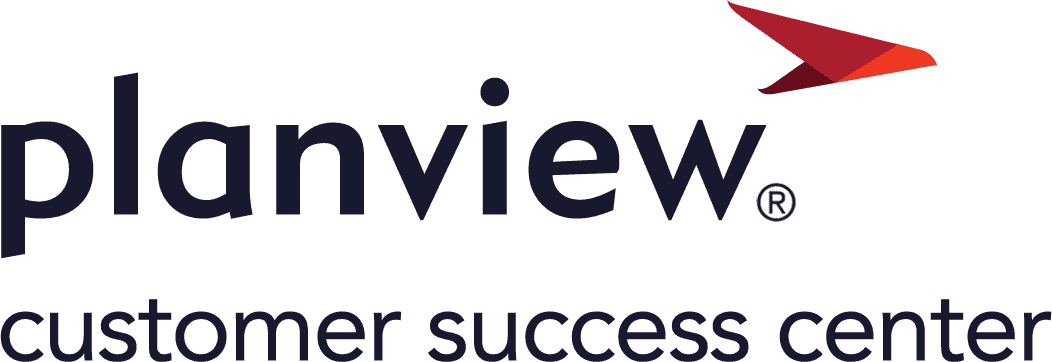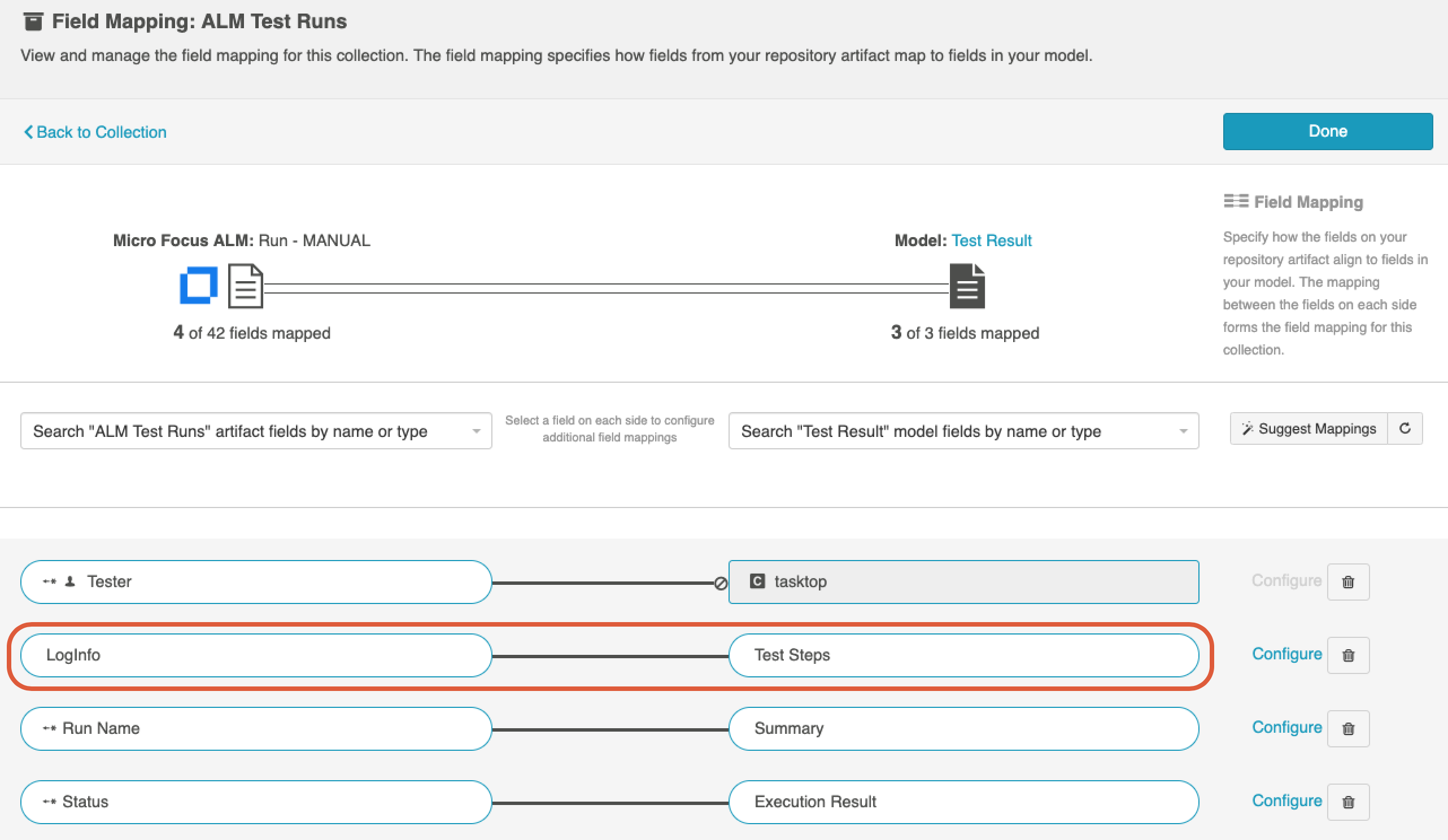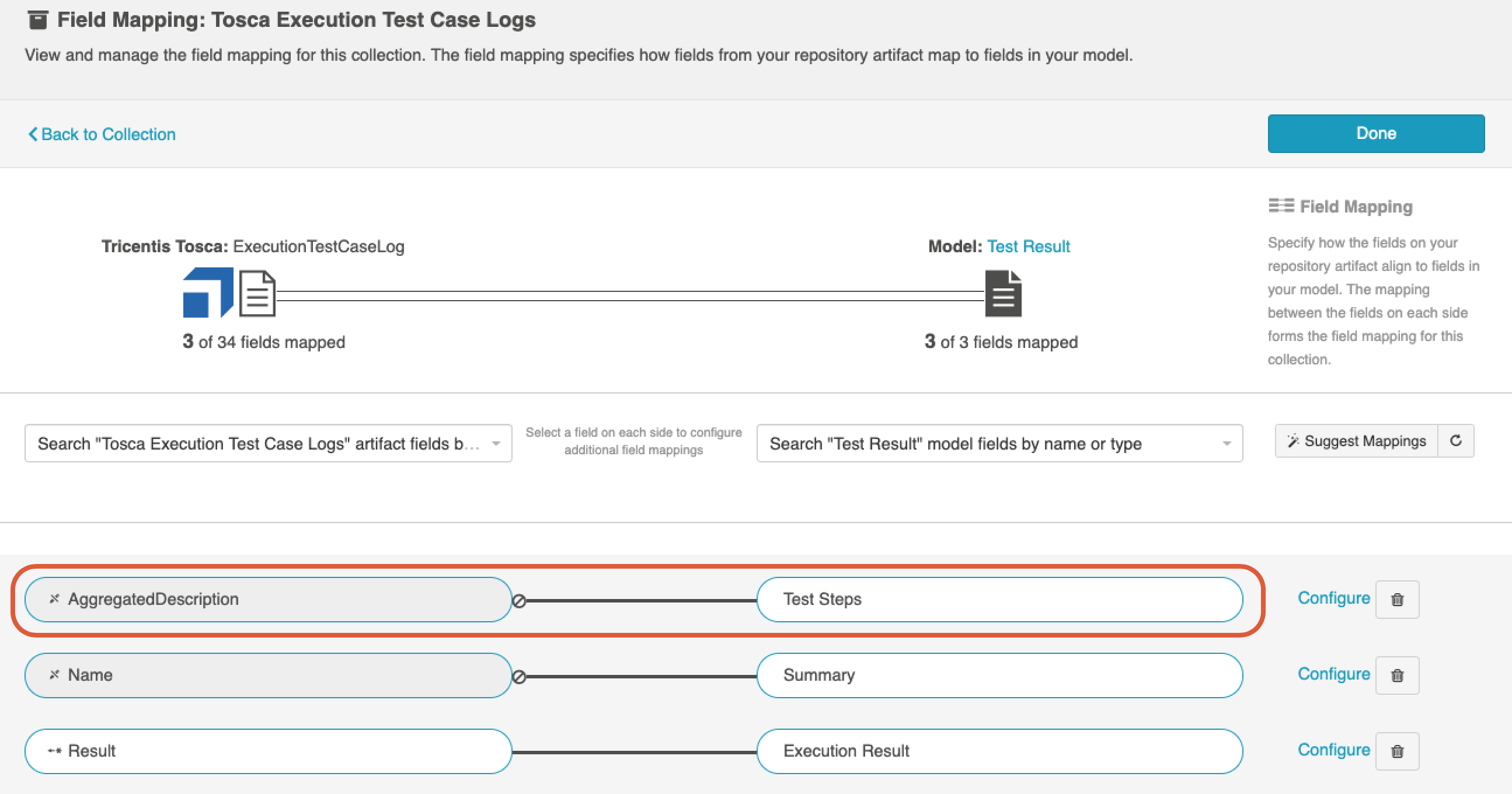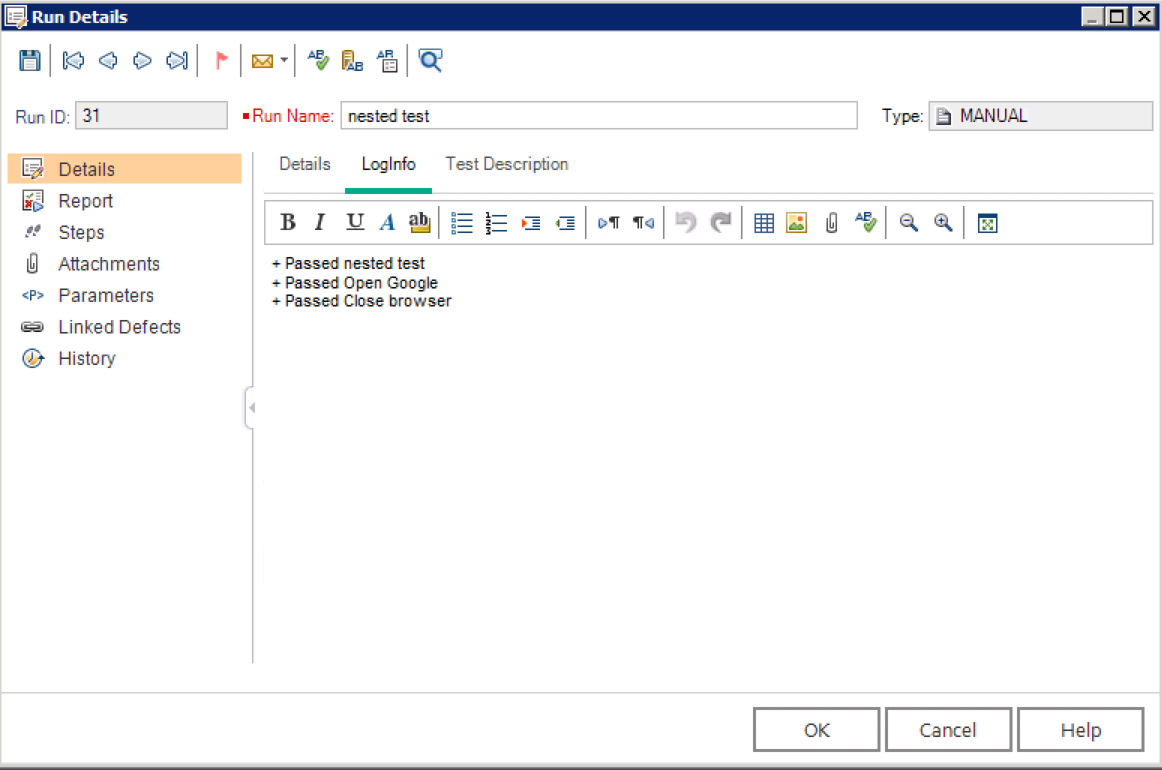Tricentis Tosca
- Last updated
- Save as PDF
Overview
Planview Hub offers integration solutions to flow test artifacts such as test results, test steps, and their associated tests, test runs, test instances, and folder structures.
Please review the sections below to learn more about supported test scenarios using Tricentis Tosca.
Tricentis Tosca & Microsoft Azure DevOps
In this integration scenario, a tester creates a test case in Azure DevOps. Hub will flow the test case, along with its fields and sub-entities to Tosca, so that the tester in Tosca can begin running her tests. Hub will then flow the test results back over to Azure DevOps to maintain full visibility across the lifecycle.

The goal of this integration scenario is to synchronize the Tosca Test Case artifact with the Azure DevOps Test Case artifact, while including the Test Results from the Tosca artifact. To do this, you'll need to configure the following integrations:
- Tosca Test Case Folders <> Azure DevOps Test Suites
- Tosca Test Cases <> Azure DevOps Test Cases
- Tosca Execution Lists <> Azure DevOps Test Runs
- Tosca Execution Entries -> Azure DevOps Test Results
Connect to your Repositories
First, connect to your repository by following the instructions here.
You can learn more about connector-specific configuration in our Connector Docs.
Set Up your Model
Review general details on creating or reusing a model.
For this integration scenario, you will need to add the following fields to your model:
| Smart Field | Label | Type | Field Values (if applicable) |
|---|---|---|---|
| Formatted ID | Formatted ID | String | N/A |
| Summary | Summary | String | N/A |
| Description | Description | Rich Text | N/A |
| Status | Status | Single Select | New, To Do, In Progress, Done |
| Created | Created | Date Time | N/A |
| Modified | Modified | Date Time | N/A |
| Location | URL | Location | N/A |
| Parent Artifact | Parent | Relationship | N/A |
| None | Parents | Relationships | N/A |
| None | Tosca ID | String | N/A |
| None | Tosca URL | String | N/A |
| None | Azure DevOps ID | String | N/A |
| None | Azure DevOps URL | String | N/A |
Tosca
You will need to add the following custom fields to your Tosca instance:
| Name | Type |
|---|---|
| Azure DevOps ID | String |
| Azure DevOps URL | String |
Azure DevOps
You will need to add the following custom fields to your Azure DevOps instance:
| Name | Type |
|---|---|
| Tosca ID | String |
| Tosca URL | String |
Create your Collections
Tosca
For this integration scenario, you'll need to configure the following Tosca collections:
Work Item Collections
- Tosca Test Cases
- Tosca Execution Entries
- Tosca Execution Lists
Container Collections
- Tosca Test Case Folders
You can learn general details on configuring collections here:
Review the details in the sections below to ensure that any required fields are mapped in your collections.
Field Mapping
Map the following Tosca fields to the model:
| Collection | Tosca Field | Model Field |
|---|---|---|
| Tosca Test Cases | Name | Summary |
| Description | Description | |
| TestCaseWorkState | Status | |
| Azure DevOps ID | Azure DevOps ID | |
| Azure DevOps URL | Azure DevOps URL | |
| Formatted ID | Tosca ID | |
| URL | Tosca URL | |
| SynchronizationPolicy | Constant Value | |
| Tosca Test Case Folders | Name | Summary |
| Description | Description | |
| SynchronizationPolicy | Constant Value | |
| Tosca Execution Lists | Name | Summary |
| SynchronizationPolicy | Constant Value |
Relationship Specification
Configure the following relationship mappings:
| Collection | Tosca Field | Model Field |
|---|---|---|
| Tosca Test Cases | Test Folder | Parent |
| Tosca Execution Entries | Execution List | Parent Artifact |
| Tosca Test Case Folders | Parent Folder | Parent |
| Tosca Execution Lists | Execution List Folder | Parents |
Azure DevOps
For this integration scenario, you'll need to configure the following Azure DevOps collections:
Work Item Collections
- Azure DevOps Test Cases
- Azure DevOps Test Results
- Azure DevOps Test Runs
Container Collections
- Azure DevOps Test Suites
You can learn general details on configuring collections here:
Review the details in the sections below to ensure that any required fields are mapped in your collections.
Field Mapping
Map the following Azure DevOps fields to the model:
| Collection | Azure DevOps Field | Model Field |
|---|---|---|
|
Azure DevOps Test Cases |
Title | Summary |
| Description | Description | |
| State | Status | |
| Iteration Path | Constant Value | |
| Formatted ID | Azure DevOps ID | |
| URL | Azure DevOps URL | |
| Tosca ID | Tosca ID | |
| Tosca URL | Tosca URL | |
| Iteration Path | Constant Value | |
| Area Path | Constant Value | |
| Azure DevOps Test Results | Configuration | Constant Value |
| Azure DevOps Test Suites | Title | Summary |
| Description | Description | |
| Iteration Path | Constant Value | |
| Area Path | Constant Value | |
| Azure DevOps Test Runs | Summary | Summary |
Relationship Specification
Configure the following relationship mappings:
| Collection | Azure DevOps Field | Model Field |
|---|---|---|
|
Azure DevOps Test Cases |
Parent | Parent |
| Azure DevOps Test Results | Parent Test Plan | Constant Value |
| Parent Test Run | Parent | |
| Azure DevOps Test Suites | Parent | Parent |
| Azure DevOps Test Runs | Parent Test Plan | Parents |
Configure your Integrations
You can learn general details on configuring integrations here:
For this integration scenario, you will need to configure the following integrations:
- Tosca Test Case Folders <> Azure DevOps Test Suites
- Tosca Test Cases <> Azure DevOps Test Cases
- Tosca Execution Lists <> Azure DevOps Test Runs
- Tosca Execution Entries -> Azure DevOps Test Results
Review the details in the table below to ensure that your integrations are configured correctly.
| Integration | Integration Type | Artifact Creation Flow | Artifact Routing/Container Mirroring |
|---|---|---|---|
| Tosca Test Case Folders <> Azure DevOps Test Suites | Container + Work Item Synchronization | Two-way Creation | Tosca <> ADO |
| Tosca Test Cases <> Azure DevOps Test Cases | Work Item Synchronization | Two-way Creation | Tosca <> ADO |
| Tosca Execution Lists <> Azure DevOps Test Runs | Work Item Synchronization | Two-way Creation | Tosca <> ADO |
| Tosca Execution Entries -> Azure DevOps Test Results | Work Item Synchronization | Two-way Creation | Tosca <> ADO |
Functional Limitations
| Category | Limitation | Applicable Repository Version |
|---|---|---|
| Third Party API Limitation |
Test Steps Due to an API limitation in ADO, Test Step integration is not supported. |
Any supported repository version: |
| Good to Know |
Actual Results Field The Actual Result fields in Tosca for Execution Entry and Test Results is read-only. As a result, the Execution Entry/Test Results integration is only one-way from Tosca to ADO. |
Any supported repository version: |
| Good to Know |
Set Execution List The Set Execution List in Tosca for Execution Entry and Test Results is a constant value. |
Any supported repository version: |
Tricentis Tosca & Micro Focus ALM/QC
In this integration scenario, a tester creates a test case in Tosca. Hub will flow the test case, along with its fields and sub-entities to ALM, so that the tester in ALM can begin running his tests.
 The goal of this integration scenario is to synchronize the Tosca Test Case artifact with the ALM Test artifact.To do this, you'll need to configure the following integrations:
The goal of this integration scenario is to synchronize the Tosca Test Case artifact with the ALM Test artifact.To do this, you'll need to configure the following integrations:
- Tosca Test Case Folders <> ALM Test Folders
- Tosca Test Cases <> ALM Test Cases
Connect to your Repositories
First, connect to your repositories by following the instructions here.
You can learn more about connector-specific configuration in our Connector Docs.
Set Up your Model
Review general details on creating or reusing a model.
For this integration scenario, you will need to add the following fields to your model:
| Smart Field | Label | Type | Field Values (if applicable) |
|---|---|---|---|
| Summary | Summary | String | N/A |
| Description | Description | Rich Text | N/A |
| Status | Status | Single Select | Dev Deploy Ready, Resolved, Reopened, Closed, In Progress |
| Created | Created | Date Time | N/A |
| Modified | Modified | Date Time | N/A |
| Location | URL | Location | N/A |
| Parent Artifact | Parent | Relationship | N/A |
| None | Parents | Relationships | N/A |
| Formatted ID | Formatted ID | String | N/A |
| None | ALM ID | String | N/A |
| None | ALM URL | String | N/A |
Test Steps
| Smart Field | Label | Type | Field Values |
|---|---|---|---|
| None | Step Name | String | N/A |
| Action | Action | String | N/A |
| Expected Result | Expected Result | String | N/A |
| Summary | Summary | String | N/A |
| Id | Id | String | N/A |
| None | Test Step JSON | String | N/A |
Tosca
You will need to add the following custom fields to your Tosca instance:
| Name | Type |
|---|---|
| ALM ID | String |
| ALM URL | String |
Create your Collections
Tosca
For this integration scenario, you'll need to configure the following Tosca collections:
Work Item Collections
- Tosca Test Cases
Container Collections
- Tosca Test Folders
You can learn general details on configuring collections here:
Review the details in the sections below to ensure that any required fields are mapped in your collections.
Field Mapping
Map the following Tosca fields to the model:
| Collection | Tosca Field | Model Field |
|---|---|---|
| Tosca Test Cases | Name | Summary |
| Description | Description | |
| TestCaseWorkState | Status | |
| CreatedAt | Created | |
| ALM URL | ALM URL | |
| ALM ID | ALM ID | |
| Tosca Test Folders | Name | Summary |
| Description | Description | |
| SynchronizationPolicy | Constant Value |
Test Step Field Mapping
| Collection | Tosca Field | Model Field |
|---|---|---|
| Tosca Test Cases | Test Step JSON | Test Step JSON |
| Name | Action | |
| UniqueId | Id |
Relationship Specification
Configure the following relationship mappings:
| Collection | Tosca Field | Model Field |
|---|---|---|
| Tosca Test Cases | Test Folder | Parents |
| Tosca Test Folders | Parent Folder | Parent |
Micro Focus ALM/QC
For this integration scenario, you'll need to configure the following Tosca collections:
Work Item Collections
- ALM Tests
Container Collections
- ALM Test Folders
Field Mapping
Map the following ALM fields to the model:
| Collection | ALM Field | Model Field |
|---|---|---|
| ALM Tests | Test Name | Summary |
| Description | Description | |
| Status | Status | |
| Created Date | Created | |
| Formatted ID | ALM ID | |
| URL | ALM URL | |
| ALM Test Folders | Name | Summary |
| Description | Description |
Test Step Field Mapping
Map the following ALM test step fields to the model:
| Collection | ALM Field | Model Field |
|---|---|---|
| ALM Tests | Step Name | Step Name |
| Description | Action | |
| Expected Result | Expected Result | |
| Step Name | Summary | |
| Step Id | Id |
Relationship Specification
Configure the following relationship mappings:
| Collection | ALM Field | Model Field |
|---|---|---|
| ALM Tests | Requirement Coverage | Parents |
| ALM Test Folders | Parent Folder | Parent |
Configure your Integrations
You can learn general details on configuring integrations here:
For this integration scenario, you will need to configure the following integrations:
- Tosca Test Case Folders <> ALM Test Folders
- Tosca Test Cases <> ALM Tests
Review the details in the table below to ensure that your integrations are configured correctly.
| Integration | Integration Type | Artifact Creation Flow | Artifact Routing/Container Mirroring | Test Step Flow |
|---|---|---|---|---|
| Tosca Test Case Folders <> ALM Test Folders | Container + Work Item Synchronization | Two-way Creation | Tosca <> ALM | N/A |
| Tosca Test Cases <> ALM Tests | Work Item Synchronization | Two-way Creation | Tosca <> ALM |
One-way Flow Tosca accepts test steps |
Functional Limitations
| Category | Limitation | Applicable Repository Version |
|---|---|---|
| Good to Know |
Test Steps Test Steps are supported for Test Case and Test Run/Execution Entry Results, but you must select which direction you want them to flow upon initial integration set-up. |
Any supported repository version: |
Tricentis Tosca & Jira Xray
In this integration scenario, a tester creates a test case in Xray. Hub will flow the test case, along with its fields and sub-entities to Tosca, so that the tester in Tosca can begin running his tests. Hub will then flow the test results back over to Xray to maintain full visibility across the lifecycle.

The goal of this integration scenario is to synchronize the Tosca Test Case artifact with the Xray Test artifact, while including the test results from the Tosca artifact. To do this, you'll need to configure the following integrations:
- Tosca Test Case Folders <> Xray Test Sets
- Tosca Test Cases <> Xray Test Cases
- Tosca Execution List Folders <> Xray Test Plans
- Tosca Execution Lists <> Xray Test Executions
- Tosca Execution Entries -> Xray Test Runs
Connect to your Repositories
First, connect to your repository by following the instructions here.
You can learn more about connector-specific configuration in our Connector Docs.
Set Up your Model
Review general details on creating or reusing a model.
For this integration scenario, you will need to add the following fields to your model:
| Smart Field | Label | Type | Field Values |
|---|---|---|---|
| Summary | Summary | String | N/A |
| Description | Description | Rich Text | N/A |
| Formatted ID | Formatted ID | String | N/A |
| Status | Status | Single Select | New, To Do, In Progress, Done |
| Created | Created | Date Time | N/A |
| Modified | Modified | Date Time | N/A |
| None | Parents | Relationships | N/A |
| Parent Artifact | Parent | Relationship | N/A |
| Location | URL | Location | N/A |
| None | Tosca ID | String | N/A |
| None | Tosca URL | String | N/A |
| None | Test Status | Single Select | Untested, Blocked, Failed, Retest, Passed |
Test Steps
| Smart Field | Label | Type | Field Values |
|---|---|---|---|
| Action | Action | String | N/A |
| Expected Result | Expected Result | String | N/A |
| Id | Id | String | N/A |
| None | Test Step JSON | String | N/A |
Xray
You will need to add the following custom fields to your Xray instance:
| Name | Type |
|---|---|
| Tosca ID | String |
| Tosca URL | String |
Create your Collections
You can learn general details on configuring collections here:
Review the details in the sections below to ensure that any required fields are mapped in your collections.
Tosca
For this integration scenario, you'll need to configure the following Tosca collections:
Work Item Collections
- Tosca Test Case Folders
- Tosca Test Cases
- Tosca Execution List Folders
- Tosca Execution Lists
- Tosca Execution Entries
Field Mapping
Map the following Tosca fields to the model:
| Collection | Tosca Field | Model Field |
|---|---|---|
| Tosca Test Case Folders | Summary | Summary |
| Description | Description | |
| URL | Tosca URL | |
| Formatted ID | Tosca ID | |
| SynchronizationPolicy | Constant Value | |
| Tosca Test Cases | Name | Summary |
| Description | Description | |
| Formatted ID | Tosca ID | |
| URL | Tosca URL | |
| TestCaseWorkState | Status | |
| SynchronizationPolicy | Constant Value | |
| Tosca Execution List Folders | Name | Summary |
| Description | Description | |
| Formatted ID | Tosca ID | |
| URL | Tosca URL | |
| SynchronizationPolicy | Constant Value | |
| Tosca Execution Lists | Name | Summary |
| Description | Description | |
| Formatted ID | Tosca ID | |
| URL | Tosca URL | |
| SynchronizationPolicy | Constant Value | |
| Tosca Execution Entries | ActualResult | Test Status |
Test Step Field Mapping
Map the following Tosca fields to the model:
| Collection | Tosca Field | Model Field |
|---|---|---|
| Tosca Test Cases | Description | Expected Result |
| Name | Action | |
| UniqueId | Id | |
| Test Step JSON | Test Step JSON |
Relationship Specification
Configure the following relationship mappings:
| Collection | Tosca Field | Model Field |
|---|---|---|
| Tosca Test Cases | Test Folder | Parents |
| Tosca Execution Lists | Execution List Folder | Parents |
| Tosca Execution Entries | Execution List | Parent |
| TestCase | Test Coverage |
Xray
For this integration scenario, you'll need to configure the following Xray collections:
Work Item Collections
- Xray Test Sets
- Xray Tests
- Xray Test Plans
- Xray Test Runs
- Xray Test Executions
Field Mapping
Map the following Xray fields to the model:
| Collection | Xray Field | Model Field |
|---|---|---|
| Xray Test Sets | Summary | Summary |
| Description | Description | |
| Tosca ID | Tosca ID | |
| Tosca URL | Tosca URL | |
| Priority | Constant Value | |
| Xray Tests | Summary | Summary |
| Description | Description | |
| Tosca ID | Tosca ID | |
| Tosca URL | Tosca URL | |
| Status | Status | |
| Priority | Constant Value | |
| Xray Test Plans | Summary | Summary |
| Tosca ID | Tosca ID | |
| Tosca URL | Tosca URL | |
| Priority | Constant Value | |
| Xray Test Executions | Summary | Summary |
| Description | Description | |
| Tosca ID | Tosca ID | |
| Tosca URL | Tosca URL | |
| Key | Formatted ID | |
| URL | URL | |
| Priority | Constant Value | |
| Xray Test Runs | Status | Test Status |
Test Step Field Mapping
Map the following Tosca fields to the model:
| Collection | Xray Field | Model Field |
|---|---|---|
| Xray Tests | Test Step Action | Action |
| Expected Result | Expected Result | |
| Id | Id |
Relationship Specification
Configure the following relationship mappings:
| Collection | Xray Field | Model Field |
|---|---|---|
| Xray Tests | Test Sets association with a Test | Parents |
| Xray Test Executions | Test Plan | Parents |
| Xray Test Runs | Test Run Test Execution key | Parent |
| Test Run Test key | Test Coverage |
Configure your Integrations
You can learn general details on configuring integrations here:
For this integration scenario, you will need to configure the following integrations:
- Tosca Test Case Folders <> Xray Test Sets
- Tosca Test Cases <> Xray Tests
- Tosca Execution List Folders <> Xray Test Plans
- Tosca Execution Lists <> Xray Test Executions
- Tosca Execution Entries -> Xray Test Runs
Review the details in the table below to ensure that your integrations are configured correctly.
| Integration | Integration Type | Artifact Creation Flow | Artifact Routing | Test Step Flow |
|---|---|---|---|---|
| Tosca Test Case Folders <> Xray Test Sets | Work Item Synchronization | Two-way Creation | Tosca <> Xray | N/A |
| Tosca Test Cases <> Xray Tests | Work Item Synchronization | Two-way Creation | Tosca <> Xray |
One-way Flow Tosca accepts test steps |
| Tosca Execution List Folders <> Xray Test Plans | Work Item Synchronization | Two-way Creation | Tosca <> Xray | N/A |
| Tosca Execution Lists <> Xray Test Executions | Work Item Synchronization | Two-way Creation | Tosca <> Xray | N/A |
| Tosca Execution Entries -> Xray Test Runs | Work Item Synchronization |
One-way Creation Xray accepts new artifacts |
Tosca -> Xray | N/A |
Functional Limitations
| Category | Limitation | Applicable Repository Version |
|---|---|---|
| Third Party Functional Limitation |
Test Plan & Test Execution Under the Jira Standard plan, synchronizing the hierarchical relationship between Test Plan and Test Execution is not supported while preserving their distinct issue types. |
Any supported repository version: |
| Good to Know |
Test Steps Test Steps are supported for Test Cases, but you must select which direction you want them to flow upon initial integration set-up. |
Any supported repository version: |
|
Good to Know
|
Test Case Integration The Test Case integration can be bidirectional as long as the Test Case Folder in Tosca is specified. |
Any supported repository version: |
|
Good to Know
|
Execution List Integration The Execution List integration can be bidirectional as long as the Execution List Folder in Tosca is specified. |
Any supported repository version: |
|
Third Party API Limitation
|
Execution Entries Due to a third party API limitation, Execution Entry fields are read-only. As a result, integrations including Execution Entries should be one-way from Tosca into Xray. |
Any supported repository version: |
| Feature Unsupported |
Test Step Results Test Step Results are not supported. |
Any supported repository version: |
Tricentis Tosca & Micro Focus ALM Octane
In this integration scenario, a tester creates a test case in ALM Octane. Hub will flow the test case, along with its fields and sub-entities to Tosca, so that the tester in Tosca can begin running her tests. Hub will then flow the test results back over to ALM Octane to maintain full visibility across the lifecycle.

The goal of this integration scenario is to synchronize the Tosca Test Case artifact with the ALM Octane Test artifact, while including the test results from the Tosca artifact. To do this, you'll need to configure the following integrations:
- Tosca Test Case Folders <> ALM Octane Test Suites
- Tosca Test Cases <> ALM Octane Tests
- Tosca Execution Entries -> ALM Octane Runs
Connect to your Repositories
First, connect to your repository by following the instructions here.
You can learn more about connector-specific configuration in our Connector Docs.
Set Up your Model
Review general details on creating or reusing a model.
For this integration scenario, you will need to add the following fields to your model:
| Smart Field | Label | Type | Field Values |
|---|---|---|---|
| Summary | Summary | String | N/A |
| Description | Description | Rich Text | N/A |
| Formatted ID | Formatted ID | String | N/A |
| Status | Status | Single Select | New, To Do, In Progress, Done |
| Created | Created | Date Time | N/A |
| Modified | Modified | Date Time | N/A |
| Location | URL | Location | N/A |
| None | Test Status | Single Select | Untested, Blocked, Failed, Retest, Passed |
| None | Key | Relationship | N/A |
| None | Octane ID | String | N/A |
| None | Octane URL | String | N/A |
| None | Tosca ID | String | N/A |
| None | Tosca URL | String | N/A |
Tosca
You will need to add the following custom fields to your Tosca instance:
| Name | Type |
|---|---|
| Octane ID | String |
| Octane URL | String |
ALM Octane
You will need to add the following custom fields to your ALM Octane instance:
| Name | Type |
|---|---|
| Tosca ID | String |
| Tosca URL | String |
Create your Collections
You can learn general details on configuring collections here:
Review the details in the sections below to ensure that any required fields are mapped in your collections.
Tosca
For this integration scenario, you'll need to configure the following Tosca collections:
Work Item Collections
- Tosca Test Cases
- Tosca Execution Entries
Container Collections
- Tosca Test Case Folders
Field Mapping
Map the following Tosca fields to the model:
| Collection | Tosca Field | Model Field |
|---|---|---|
| Tosca Test Case Folders | Name | Summary |
| Description | Description | |
| Synchronization Policy | Constant Value | |
| Tosca Test Cases | Name | Summary |
| Description | Description | |
| TestCaseWorkState | Status | |
| Octane ID | Octane ID | |
| Octane URL | Octane URL | |
| Formatted ID | Tosca ID | |
| URL | Tosca URL | |
| SynchronizationPolicy | Constant Value | |
| Tosca Execution Entries | Name | Summary |
| CreatedAt | Created | |
| Formatted ID | Tosca ID | |
| URL | Tosca URL | |
| ActualResult | Test Status |
Relationship Specification
Configure the following relationship mappings:
| Collection | Tosca Field | Model Field |
|---|---|---|
| Tosca Execution Entries | TestCase | Key |
ALM Octane
For this integration scenario, you'll need to configure the following ALM Octane collections:
Work Item Collections
- ALM Octane Tests
- ALM Octane Runs
Container Collections
- ALM Octane Test Suites
Field Mapping
Map the following ALM Octane fields to the model:
| Collection | ALM Octane Field | Model Field |
|---|---|---|
| ALM Octane Test Suites | Name | Summary |
| Description | Description | |
| ALM Octane Tests | Name | Summary |
| Description | Description | |
| Phase | Status | |
| Tosca ID | Tosca ID | |
| Tosca URL | Tosca URL | |
| Formatted ID | Octane ID | |
| URL | Octane URL | |
| ALM Octane Runs | Name | Summary |
| Creation time | Created | |
| Tosca ID | Tosca ID | |
| Tosca URL | Tosca URL | |
| Native status | Test Status | |
| Release | Constant Value |
Relationship Specification
Configure the following relationship mappings:
| Collection | ALM Octane Field | Model Field |
|---|---|---|
| ALM Octane Runs | Test | Key |
Configure your Integrations
You can learn general details on configuring integrations here:
For this integration scenario, you will need to configure the following integrations:
- Tosca Test Case Folders <> ALM Octane Test Suites
- Tosca Test Cases <> ALM Octane Tests
- Tosca Execution Entries -> ALM Octane Runs
Review the details in the table below to ensure that your integrations are configured correctly.
| Integration | Integration Type | Artifact Creation Flow | Artifact Routing/Container Mirroring | Test Step Flow |
|---|---|---|---|---|
| Tosca Test Case Folders <> ALM Octane Test Suites | Container + Work Item Synchronization | Two-way Creation | Tosca <> ALM Octane | N/A |
| Tosca Test Cases <> ALM Octane Tests | Work Item Synchronization | Two-way Creation | Tosca <> ALM Octane |
One-way Flow ALM Octane accepts test steps |
| Tosca Execution Entries -> ALM Octane Runs | Work Item Synchronization |
One-way Creation ALM Octane accepts new artifacts |
Tosca -> ALM Octane | N/A |
Functional Limitations
| Category | Limitation | Applicable Repository Version |
|---|---|---|
| Good to Know |
Test Steps Test Steps are supported for Test Cases, but you must select which direction you want them to flow upon initial integration set-up. |
Any supported repository version: |
| Third Party API Limitation |
Execution Entries Due to a third party API limitation, Execution Entry fields are read-only. As a result, integrations including Execution Entries should be one-way from Tosca into ALM Octane. |
Any supported repository version: |
Synchronizing Test Results between Tosca & ALM
Many organizations have been using Micro Focus ALM/Quality Center for quality management for years. But where once it was the only tool used for testing, today enterprises are augmenting ALM with additional tools to align with their agile and test automation efforts. That includes tools like Tricentis Tosca. Even as new tools are introduced, ALM remains popular and continues to play an important role in test management, especially when it comes to manual testing, defect management, and quality reporting.
The challenges for QA teams and leadership are how to restore visibility into coverage, quality, and cost, now that testing data is split across multiple tools.
Planview Hub enables users to flow test results into Micro Focus ALM in order to take advantage of ALM's reporting capabilities while using other tools, such as Tricentis Tosca, for their test planning and execution.
The method outlined below will enable you to flow test results into Micro Focus ALM from Tricentis Tosca or from another ALM instance. Due to the architectural specificity of each external tool, the methods below cannot be used for other endpoints.
You can watch this demo video to learn more:
Test Architecture
Before you begin configuring your integration, it's important to understand how test artifacts relate to one another.
While the goal of this integration is to flow test results, the architecture required to do so is more complex than one might assume. Test Results are a field on Test Runs. To create a Test Run in ALM, a Test Instance must exist. For a Test Instance to exist, both a Test and a Test Set must exist (the test is 'added' to the test set and that creates a test instance). For a Test to exist, you need a Test Folder. And for a Test Instance to exist, you need a Test Set and a Test Set Folder. That's 6 different artifacts, just to flow a Test Run!
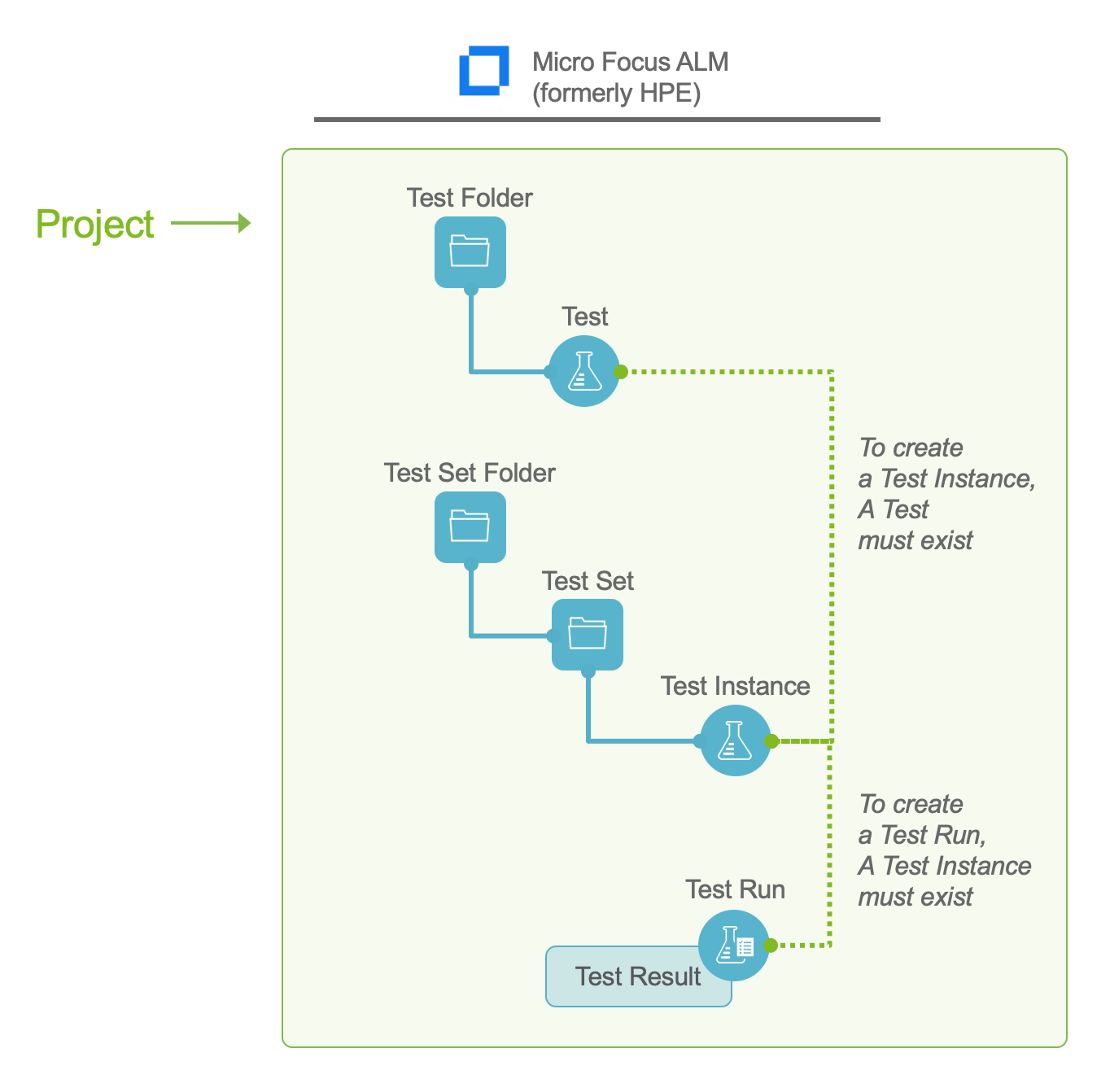
But don't worry — instead of six complex integrations, Hub cuts that configuration in half. To set up this integration scenario, you will set up three integrations:
| Integration | Container A | Container B | Work Item |
|---|---|---|---|
| Test Design |
Test Folder |
-- | Test |
| Test Planning |
Test Set Folder |
Test Set | Test Instance |
| Test Execution | -- | -- | Test Run |
Once configured, your integrations will look like the images below.
Note: To keep your integrations in order, we recommend appending a number to the beginning of each title (i.e., "1 - Test Design," "2 - Test Planning," "3 - Test Execution").
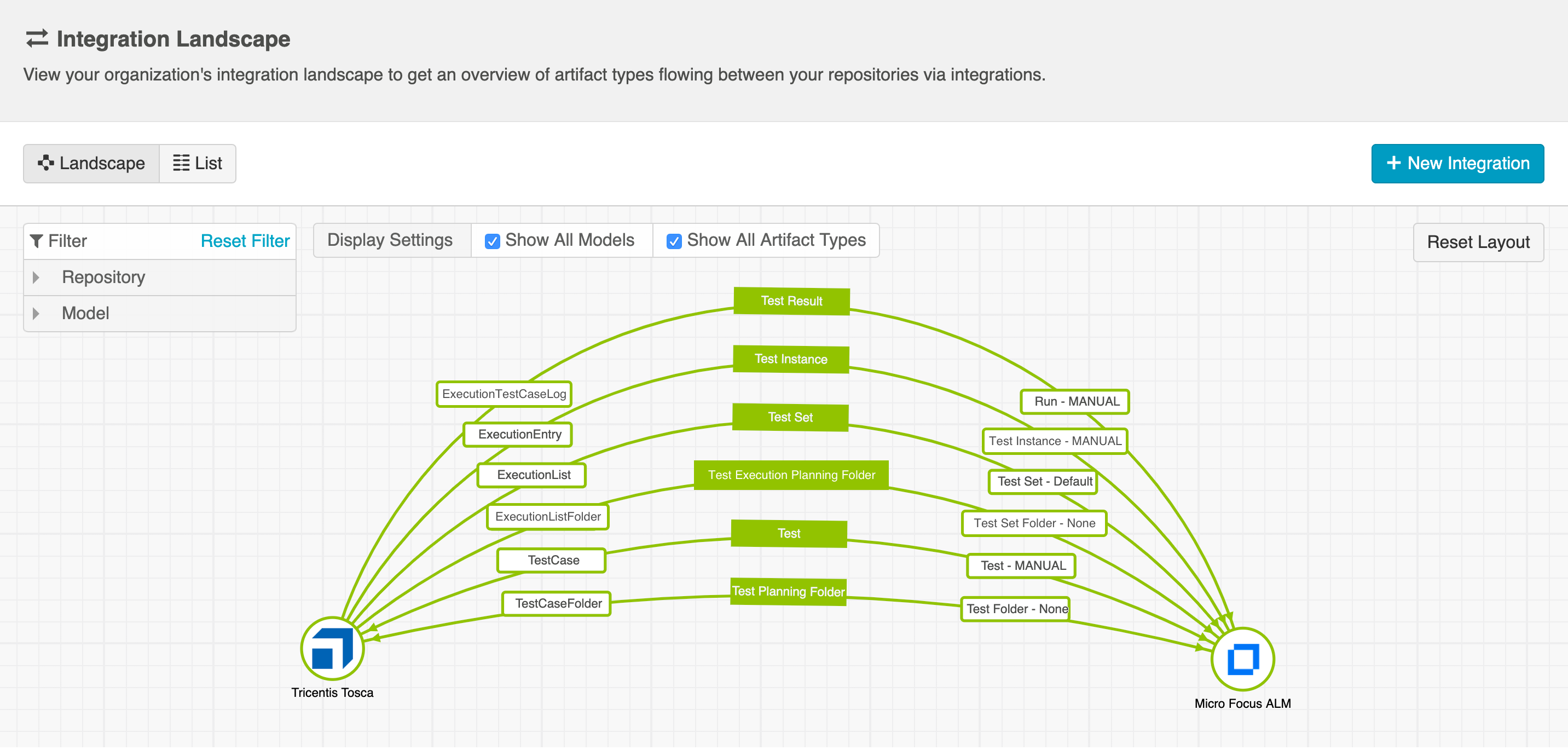
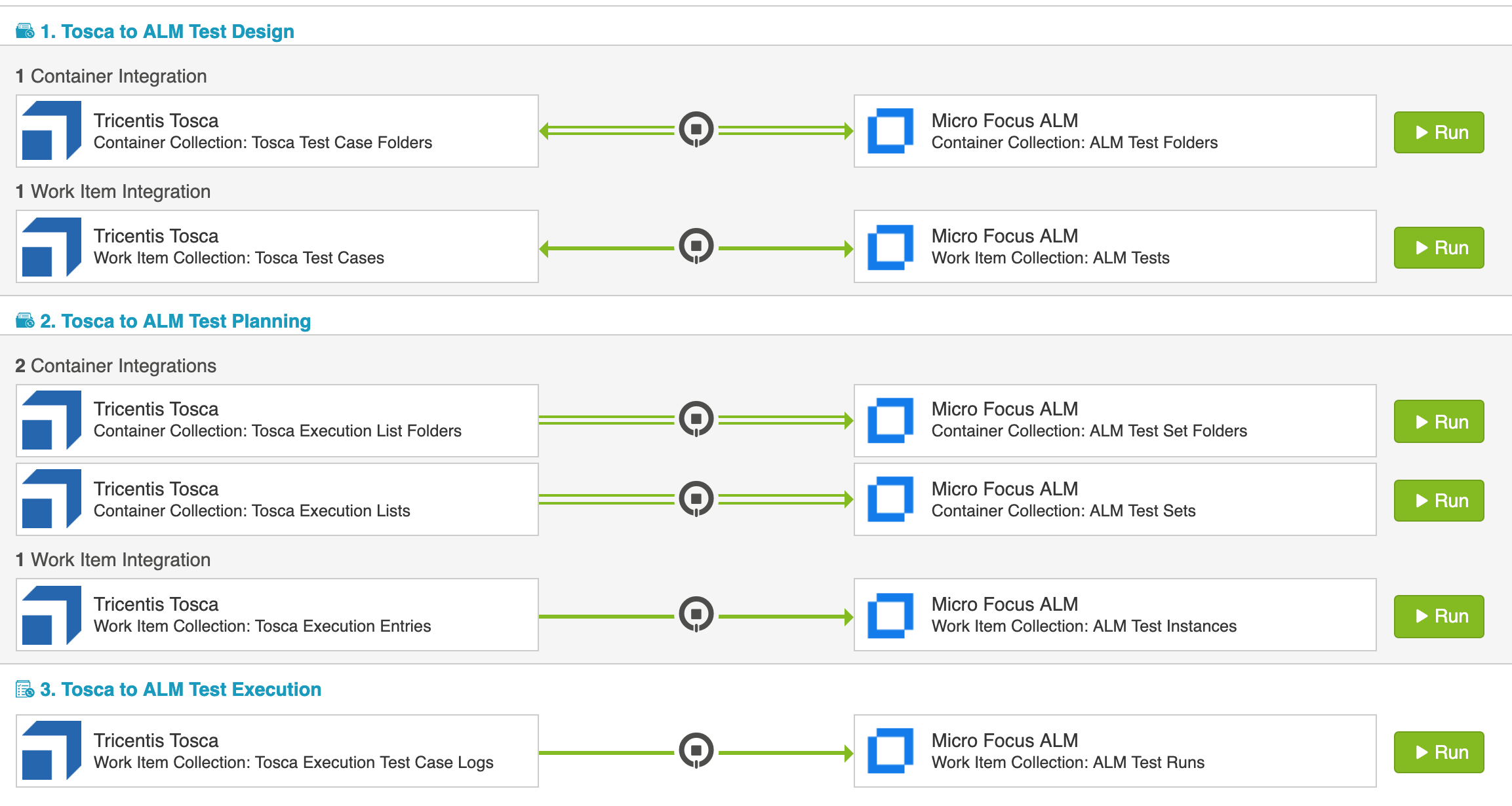
Before You Begin
Before you get started, you should familiarize yourself with the following steps of integration configuration:
Step 1: Connect to your Repository
Step 2: Construct your Model
Step 3: Create your Collection
Review the details in the sections below to ensure that any required fields are mapped in your collection
Step 4: Configure your Integration
Integration 1: Test Design
The first integration you will configure is a Container + Work Item Synchronization flowing Test Folders/Test Case Folders (container) and Tests/Test Cases (work item).

Supported Containers:
- Micro Focus ALM Test Folders
- Parent field must be mapped to preserve folder hierarchy
- Tricentis Tosca Test Case Folders
- Parent field must be mapped to preserve folder hierarchy
Supported Artifacts:
- Micro Focus ALM Tests
- Subject field must be mapped (this points to the Test folder)
- When flowing tests out of ALM, multiple test configurations are not supported. Tests must have a single test configuration.
- Tricentis Tosca Test Cases
- Test Case Folder field must be mapped
This integration can be run independently, as the Test Folders and Tests do not require any other artifacts to exist before they can be created. Artifact Creation Flow can be one-way or two-way.
Integration 2: Test Planning
The Test Planning integration is a Container + Work Item Synchronization that utilizes child containers, flowing Test Set Folders/Execution List Folders (container), Test Sets/Execution Lists (child container), and Test Instances/Execution Entries (Work Item).
Note: You should not map the Status field in the Test Planning integration. The status field should only be mapped in the Test Execution integration.

To configure this integration, you will use the normal 'Container + Work Item Synchronization' template. Hub has behind-the-scenes magic that will allow you to include a child-container integration once it sees the appropriate collections created:
Container Collections:
- ALM Test Set Folders
- Parent field must be mapped to preserve folder hierarchy
- Tosca Execution List Folders
- Parent field must be mapped to preserve folder hierarchy
Child Container Collections:
- ALM Test Sets
- Parent field must be mapped to preserve folder hierarchy
- Tosca Execution Lists
- Parent field must be mapped to preserve folder hierarchy
Work Item Collections:
- ALM Test Instances
- Test field must be mapped
- Test Set field must be mapped
- Status field must not be mapped
- Tosca Execution Entries
- Test Case field must be mapped
- Execution List field must be mapped
- Status field must not be mapped
Step 1: Test Set Folder/Execution List Folders
Once your collections have been created and configured, create a Container + Work Item Synchronization. First, configure the top-level container integration:
- ALM <=> ALM: Test Set Folder to Test Set Folder, or
- Tosca <=> ALM: Execution List Folder to Test Set Folder
Container Creation Flow will most likely be one way into ALM, but this will depend on the use case.
Once this integration has been configured, you'll see an option to create a child container integration.
Note: The Test Instance (or Execution Entry) collection (i.e., the work item collection for this integration) must exist before the "New Child Container Integration" button will appear while configuring this integration.
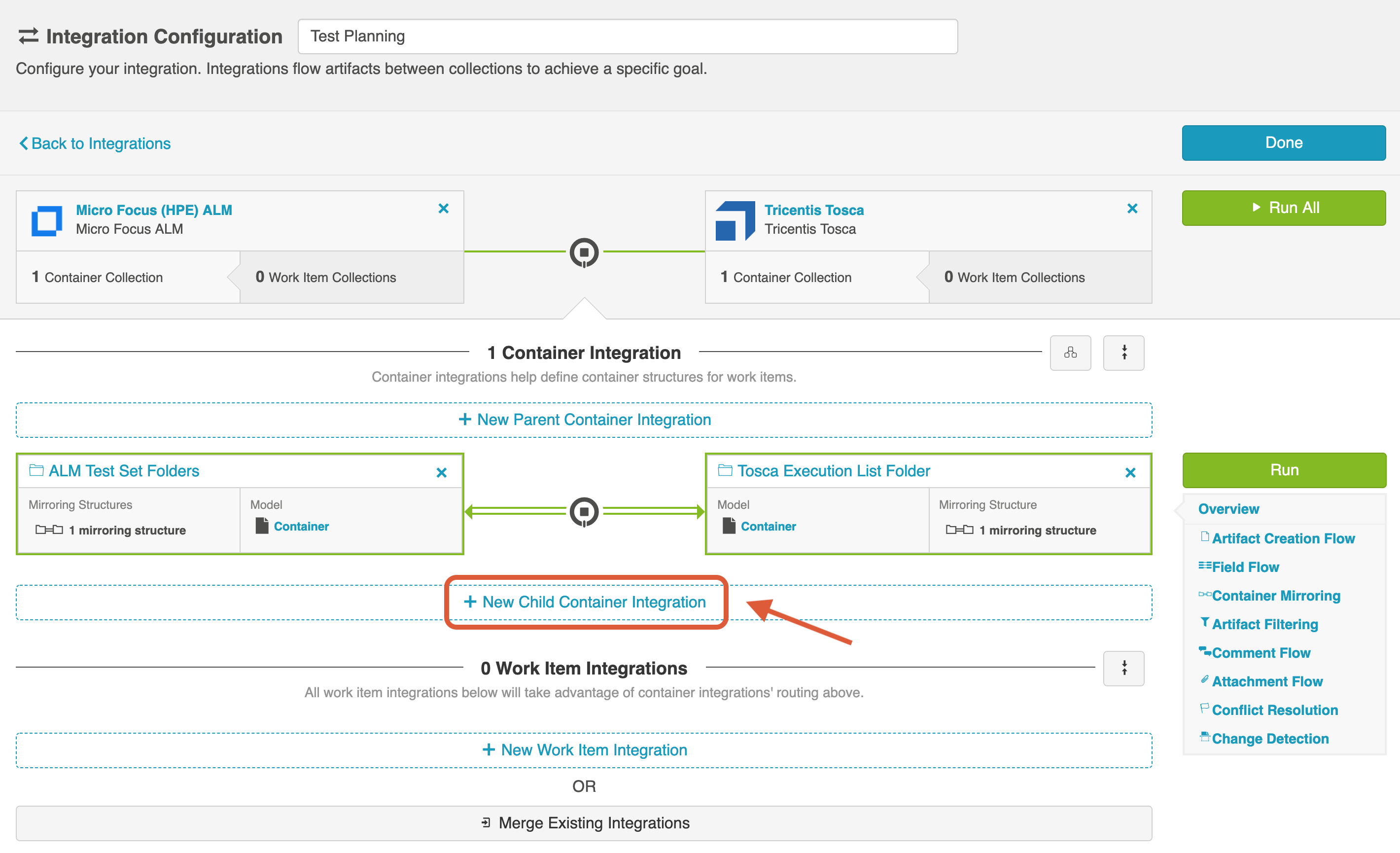
Step 2: Test Sets/Execution Lists
Your Child Container Integration will be
- ALM <=> ALM: Test Set to Test Set, or
- Tosca <=> ALM: Execution List to Test Set
This integration will likely not require container mirroring configuration, as it will inherit that from the parent container integration.
Step 3: Test Instances/Execution Entry
Finally, you will configure your Work Item integration. It will either be:
- ALM <=> ALM: Test Instance to Test Instance
- Tosca <=> ALM: Execution Entry to Test Instance
Click New Work Item Integration to add the integration.
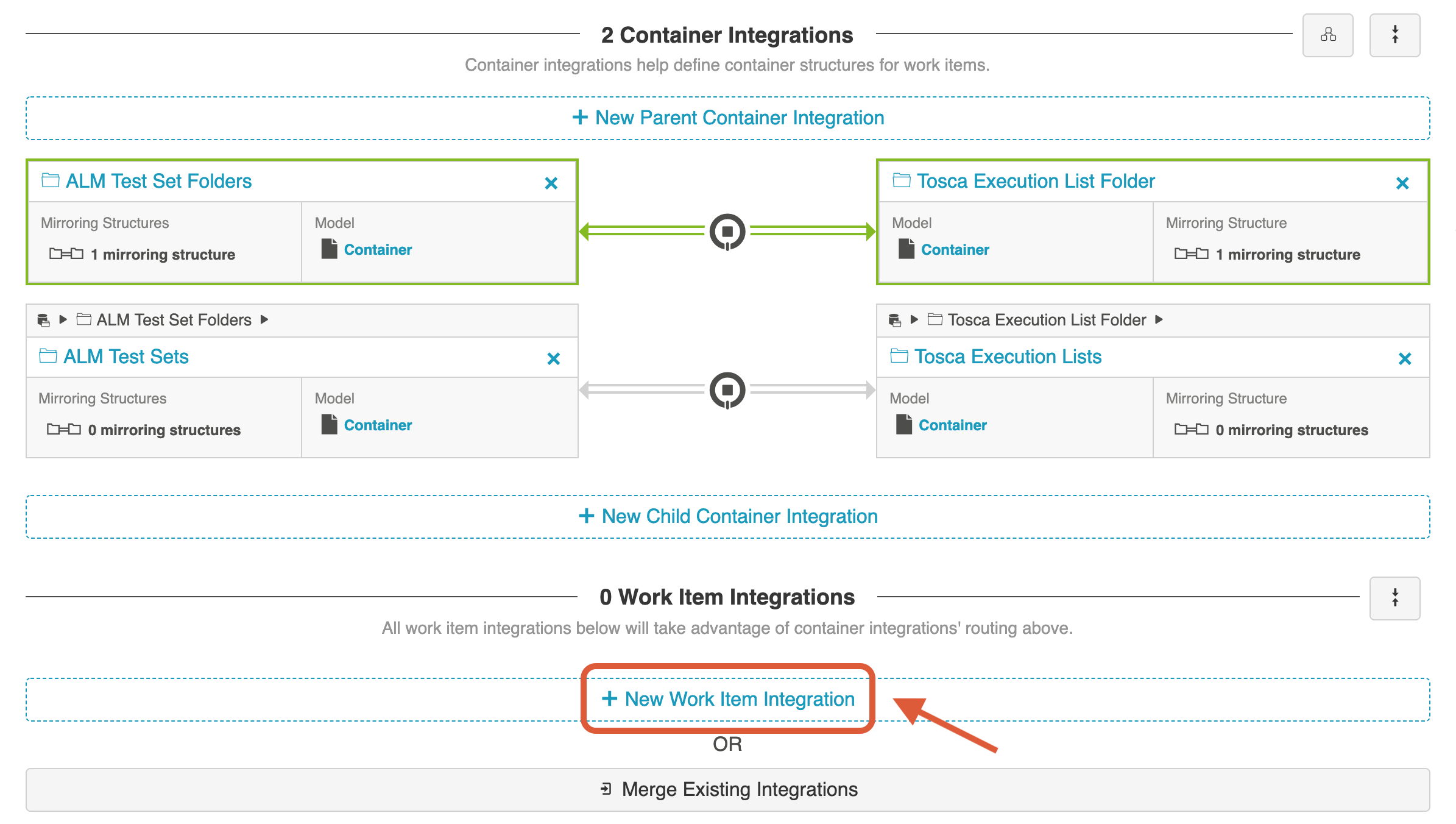
Here is what your fully configured integration will look like:
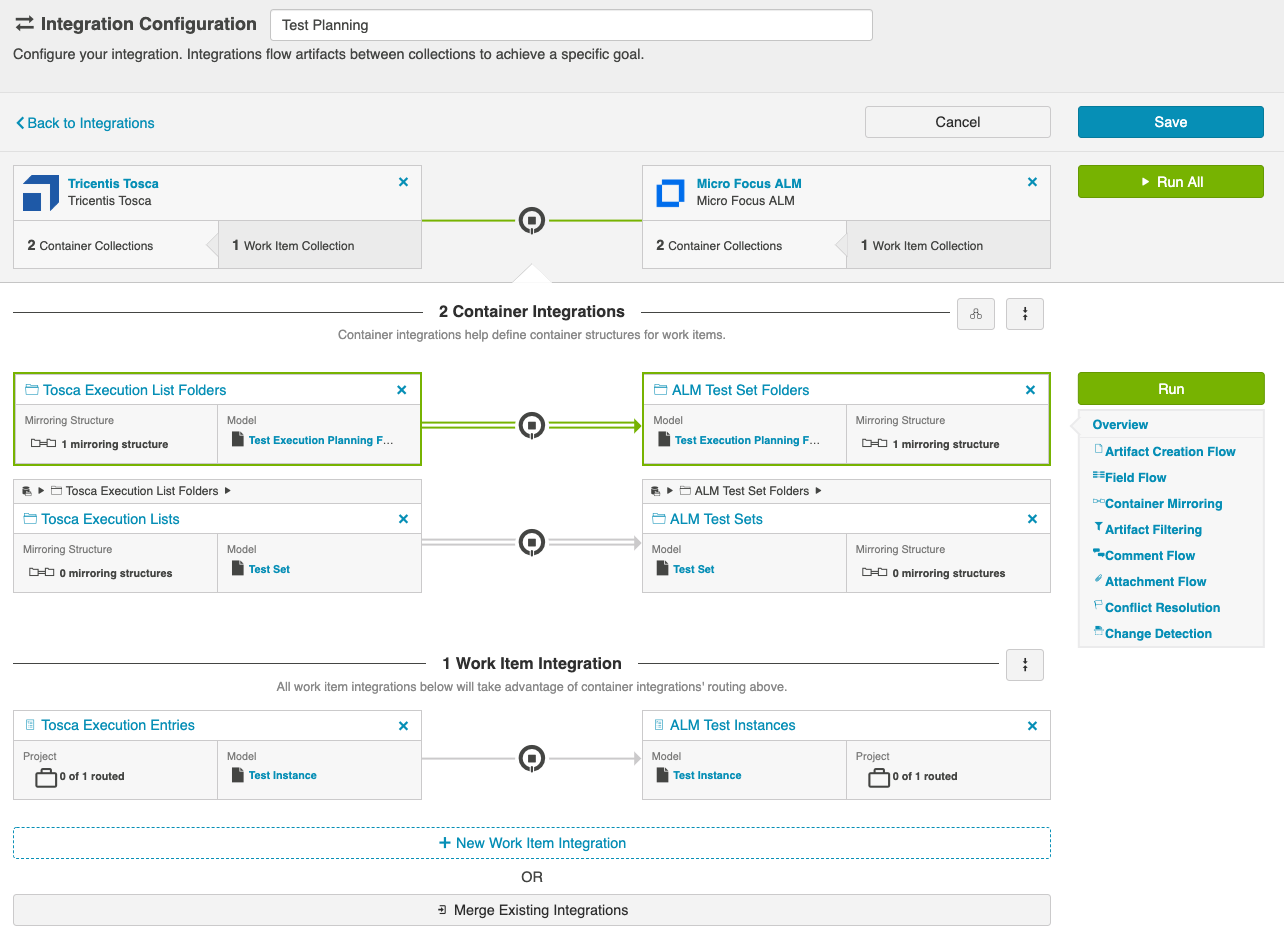
Step 4: Run Integration
Before you run this integration, you must have the Test Design integration configured and running. This is because in order to create a Test Instance, both a Test Set and a Test (created via the Test Design integration) must exist. When a Test is added to a Test Set, a Test Instance is created.
To run the integration, click the green Run All button.
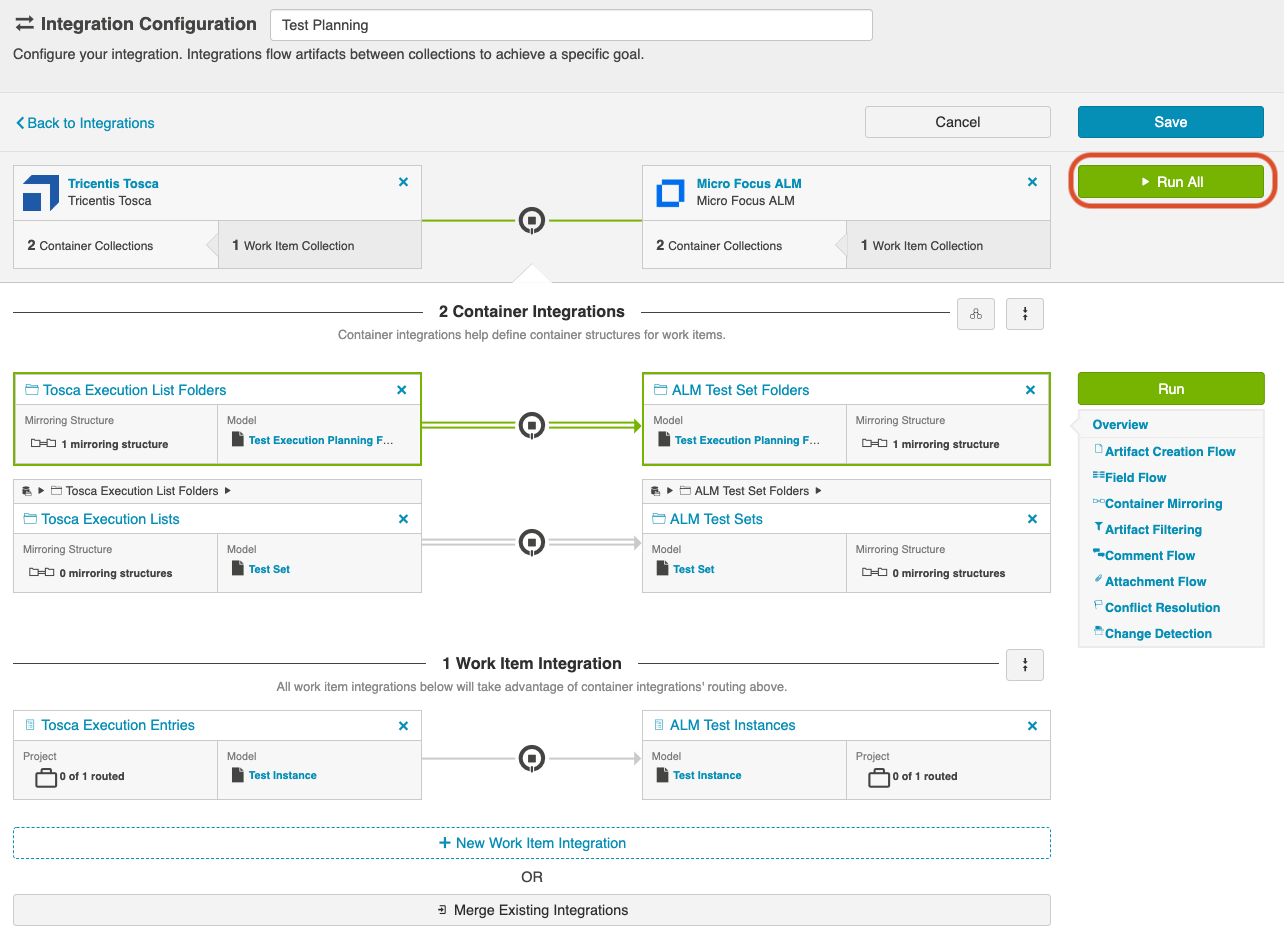
Integration 3: Test Execution
The Test Execution integration is a Work Item Synchronization that flows Test results located on ALM Test Runs or Tosca Execution Test Case Logs.

Supported Artifacts:
- ALM Test Run
- Test Instance field must be mapped
- Status field must be mapped
- Tosca Execution Test Case Log
- Execution Entry field must be mapped
- Status field must be mapped
Artifact Routing and Filtering
Because Test Runs and Execution Test Case Logs live at the project level, Artifact Routing will only need to be configured at the Project level.
Since routing is at the project level, you may be asking, "How will I know that only the Test Runs that I care about are synchronizing? I don't want every single Test Run in this project to flow!" And you're in luck. Test Execution Integrations behave a little differently from typical integrations: Hub will use built-in magic to only flow the Test Runs or Execution Test Case Logs that are associated with a Test Instance/Execution Entry that is also configured to flow.
It's that simple!
For this reason, you will see an Issue on the Activity Screen of Hub if you attempt to run this integration without running an associated Test Planning integration (Remember: Test Runs require that an associated Test Instance exist first).
Race Conditions
Due to the interdependencies between the three integrations, the order that artifacts synchronize in matters.
In this Test Management integration scenario, Hub won't create an artifact if its parent container or other required artifact does not yet exist.
Examples of when Hub won't flow a work item:
- Trying to create a Test Run without the correct Test Instance already existing in the target system
- Trying to create a Test Instance without the correct Test already existing in the target system
Here's an example of what you can expect to see in a race condition:
- Create a test instance and immediately run the test
- If Hub picks up the Test Run first, it will not have the necessary Test Instance on the target to attach to and will error
- Once Hub picks up the Test Instance & synchronizes it, then the Test Run will be able to flow across on retry and the error will clear
You are most likely to see this condition when first setting up your integrations. For this reason, we recommend setting up the integrations 'from top to bottom'. In other words, start with the Test Design integration. Then move on to the Test Planning integration. And finally, set up the Test Execution integration. If you have the integrations running in that order, you'll be more likely to flow any required artifacts before any dependent artifacts attempt to flow.
To keep your integrations in order in the Integration List View, we recommend appending a number to the beginning of each title, i.e. "1 - Test Design," "2 - Test Planning," "3 - Test Execution"
Another possible time when this race condition could occur is if you have vastly different change detection intervals on your integrations. For example, if you have a short interval on your Test Execution integration, but a much longer interval on your Test Planning integration.
Flowing Test Step Results in Tricentis Tosca
Because test steps are represented as a field on the Execution Test Case Log in Tosca, rather than as a unique child artifact (as they are in ALM), if you would like to flow test steps from ALM → Tosca or Tosca → ALM, it must be configured as part of a Test Execution integration.
To configure test step flow for Tosca, follow the instructions below:
- Create a rich text field on the model used in the Test Execution integration. For explanatory purposes, we'll call this the "Test Steps" field in the model. Since test steps are represented as a field, rather than a separate artifact, your model type will be Standard Model.
- Within ALM, create a custom text field on the ALM Test Run artifact. This field will accept the combined results of all the associated test steps from Tosca. For explanatory purposes, let's call this the LogInfo field.
- In the ALM Test Run collection, map the LogInfo field to the Test Steps field in the model.
- In the Tosca Execution Test Case Log collection, map the AggregatedDescription field to the Test Steps field in the model.
- Once the integration is run, you'll see that the results of each individual step in Tosca are now populated in the new custom LogInfo field on the ALM Test Run.
